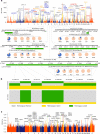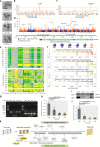Whole-genome resequencing of wild and domestic sheep identifies genes associated with morphological and agronomic traits
- PMID: 32499537
- PMCID: PMC7272655
- DOI: 10.1038/s41467-020-16485-1
Whole-genome resequencing of wild and domestic sheep identifies genes associated with morphological and agronomic traits
Abstract
Understanding the genetic changes underlying phenotypic variation in sheep (Ovis aries) may facilitate our efforts towards further improvement. Here, we report the deep resequencing of 248 sheep including the wild ancestor (O. orientalis), landraces, and improved breeds. We explored the sheep variome and selection signatures. We detected genomic regions harboring genes associated with distinct morphological and agronomic traits, which may be past and potential future targets of domestication, breeding, and selection. Furthermore, we found non-synonymous mutations in a set of plausible candidate genes and significant differences in their allele frequency distributions across breeds. We identified PDGFD as a likely causal gene for fat deposition in the tails of sheep through transcriptome, RT-PCR, qPCR, and Western blot analyses. Our results provide insights into the demographic history of sheep and a valuable genomic resource for future genetic studies and improved genome-assisted breeding of sheep and other domestic animals.
Conflict of interest statement
The authors declare no competing interests.
Figures






References
-
- Xu SS, Li MH. Recent advances in understanding genetic variants associated with economically important traits in sheep (Ovis aries) revealed by high-throughput screening technologies. Front. Agr. Sci. Eng. 2017;4:279–288.
-
- Meyer RS, et al. Domestication history and geographical adaptation inferred from a SNP map of African rice. Nat. Genet. 2016;48:1083–1088. - PubMed
-
- Zhou Z, et al. Resequencing 302 wild and cultivated accessions identifies genes related to domestication and improvement in soybean. Nat. Biotechnol. 2015;33:408–414. - PubMed
Publication types
MeSH terms
Substances
LinkOut - more resources
Full Text Sources
Other Literature Sources
Miscellaneous

